April 11

PLANT-BASED ICE CREAMS
It’s Autumn raspberry season, so I immediately crave ice cream to accompany my berries. When I visited the local supermarket I was pleasantly surprised by the range of plant-based ice creams now available. My action for today was to research the products on the market and to also try to make my own. I watched That Vegan Dad for a rundown of different brands, and I began soaking chickpeas to create a homemade batch. The liquid produced when you cook and store chickpeas or other pulses is called aquafaba. When you whip it, it resembles egg whites and is commonly used in plant-based cooking – to make meringues, pavlovas and an ice-cream base. As part of my learning journey to explore new ways of cooking I’ll report back over the next few days how it goes!
In his book Drawdown – The Most Comprehensive Plan Ever Proposed To Reverse Global Warming, Paul Hawken claims that:
what we eat turns out to be the number one of the greatest causes of global warming along with the energy supply sector. p. 37
He goes on to cite a 2016 study from the University of Oxford which found that:
Business-as-usual emissions could be reduced by as much as 70 percent through adopting a vegan diet and 63 percent for a vegetarian diet (which includes cheese, milk, and eggs). The model also calculates a reduction in global mortality of 6 to 10 percent. p. 39
That’s reason enough to learn to cook differently to what I’ve been used to.
THE WAY FORWARD
As well as individual action, change to restore planetary health is happening in every sector:

- Ecuador has become the first country to give legal rights to wild animals. Read more in Euronews
- Stanford University develops a solar cell that can generate some electricity at night. Read more in NPR
- Montreal, Canada to pedestrianize 10 of the city’s commercial streets. Read more in CULT-MTL
PLANT-BASED EATING – Celery Soup
The Planetary Health Initiative wildlife-compatible garden has been testing what can be grown without netting and celery gets a big thumbs up!

Celery is the basis of many meals, so is definitely worth growing. It can also be the main focus of a meal, like this delicious celery soup:

Celery Soup

- 2 tbsp olive oil
- 1 onion, diced
- 4 garlic cloves, roughly chopped
- 6 cups celery, sliced thin (1 extra large head, save some leaves for garnish)
- 2 cups potatoes, sliced into 1 cm thick rounds (about 360gm)
- 4 cups veggie stock
- 1 cup water
- 1 bay leaf
- 1 tsp salt
- ½ tsp pepper
- 1/8 – ¼ tsp cayenne pepper to taste
- ¼ cup fresh dill
- ½ cup fresh parsley (small stems OK)
- 1 tbsp pumpkin seeds for garnish
Stir in
- ½ cup vegan sour cream or cashew cream
-
Heat oil in a big pot over medium high heat, and add the onion, stirring occasionally, letting the onions get golden, about 5 minutes.
-
While the onions are cooking, roughly chop the garlic, celery and potatoes
-
When the onions are golden add the garlic and stir 1-2 minutes, until fragrant. Add the celery, potatoes, broth, water, bay leaf, salt, pepper, and cayenne. The liquid should just cover the veggies. Cover, bring to a rolling boil, turn heat down and simmer gently until potatoes are tender, about 10 minutes.
-
Turn heat off, remove bay leaf and add the fresh herbs and just wilt them (don't cook herbs or you lose the vibrant colour).
-
Using an immersion blender, blend until very silky smooth – OR if using a regular blender, let cool before blending in smaller batches. (Don't fill blender more than half and cover lid tightly with a towel, starting on lowest seting to avoid blender 'explosion'.)
-
Blend well, a full minute, until herbs are fully blended, creating a vibrant coloured soup. For extra 'green' colour, add a handful of raw spinach or more fresh parsley. Place it back in same pot over low heat. Stir in your choice of cream.
-
Crispy fry celery leaves and toast pumpkin seeds to garnish
WE ARE NATURE
On today’s walk at the old Katoomba Golf Course I came across this stunning Banksia Ericifolia. It flowers from Autumn through to Spring and is one of the best plants for attracting honey-eating birds – especially over winter when there may not be a lot else flowering. It was allegedly the first specimen collected by Sir Joseph Banks at Botany Bay in 1770.

PRODUCE > CONSUME
In our ongoing attempt to produce as much as we consume each day, today we sourced, cleaned and drilled holes into 2 buckets to get another few batches of oyster mushrooms started.

WHAT ARE OTHER PEOPLE DOING
Yesterday Libby and her partner bought some veggie seedlings at the farmers market and planted them all for their winter food.
The theme for World Health Day this year was Our Planet, Our Health – recognising that our health is totally dependent on the health of the earth’s natural systems.
We managed to reach our target of over 365 actions in one day – the action of a whole year in a day! You can view most of them here (others came in via social media and emails).
Now the challenge is to reach 365 actions EVERY day!
We’d love you to share your actions with us so that we can learn from each other and inspire one another to turn things around to create a healthier world.
Research by academics at Leeds University, engineering firm Arup and the C40 Cities climate group has identified that 73 per cent of all changes needed by 2030 to keep the world on course to meet the Paris agreement targets need to be made by governments and industry. But private citizens have considerable influence over the remaining 27 per cent. So let’s get cracking!



0 Comments